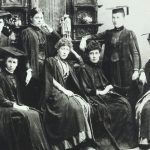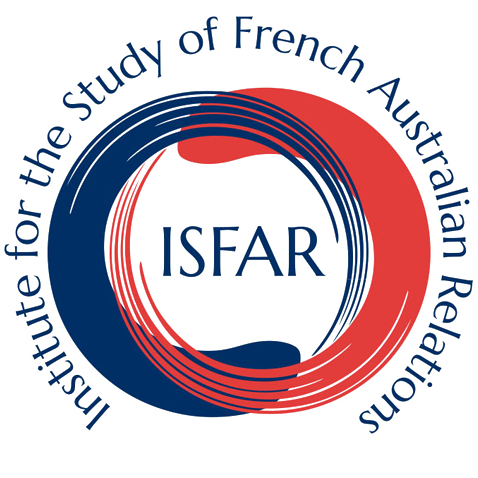 A little known historical figure, Dr Helen Sexton, one of Melbourne’s pioneering medical women, carved for herself a small piece of French-Australian history through her work in the First World War. A highly skilled surgeon, as part of a team of five Australian women, she established and ran the Hôpital Australien in Paris from June to December 1915. Her war work is symbolic of the way in which the tumultuous period of the war gave rise to a new dimension in relations between France and Australia across many sectors of society—the military, bureaucracy, the general public—and on an individual basis.
A little known historical figure, Dr Helen Sexton, one of Melbourne’s pioneering medical women, carved for herself a small piece of French-Australian history through her work in the First World War. A highly skilled surgeon, as part of a team of five Australian women, she established and ran the Hôpital Australien in Paris from June to December 1915. Her war work is symbolic of the way in which the tumultuous period of the war gave rise to a new dimension in relations between France and Australia across many sectors of society—the military, bureaucracy, the general public—and on an individual basis.
Helen was born the youngest of five children to Irish migrants Maria Bromwell and Daniel Sexton, an architect and builder. After attending Carlton Ladies’ College, she went on to study a Bachelor of Arts subject at the University of Melbourne (English 2); however her true desire was to study medicine. Barred from the Medical School because of her gender, she joined with a classmate from her Bachelor of Arts course, Lilian Alexander, to lead the hard-fought and ultimately victorious campaign for women’s entry in 1887, and seven women began their medical studies that year. The third of this original group to graduate, Helen received her Bachelor of Medicine and Bachelor of Surgery in 1892. Despite limited employment opportunities for female surgeons, Helen became involved in the formation of the Victorian Medical Women’s Society, the Queen Victoria Hospital, and was also the first female surgeon at the Women’s Hospital. Dr Sexton rapidly won for herself a reputation as a skilled surgeon, even being labelled by Punch magazine as ‘the head of the women medical profession in Melbourne’.
At the outbreak of the First World War Helen developed her connection to France. From the beginning of Australia’s entry into the conflict in August 1914, Helen had been a generous supporter of the Allied war effort. However despite being retired from active medical practice, she went further, offering her medical services to the Australian government, specifically to equip and run a hospital as a woman’s unit. The offer was declined, as the Australian military authorities had decreed that no women would be accepted for active military service. Faced with this official rejection, Helen began seeking other channels through which she might serve overseas, and gained the support of elite Melburnians, through letters of recommendation to the British authorities, from notables such as the Chief Justice Sir John Madden, the Governor General’s wife, Lady Helen Munro Ferguson, and the Governor of Victoria and his wife.
Eventually Dr Sexton served in France rather than Britain, and joined forces with Mrs William Smith, a nurse from Melbourne, who was also travelling to Europe with the same intention. With the unstinting aid of the Melbourne French community, led by Charlotte Crivelli, and with the logistical support of Crivelli’s sister Suzanne Caubet in Paris, Helen and Mrs Smith were able to get French Government consent to set up their own hospital in the French capital. Affectionately known as the Hôpital Austalien de Paris, it was to operate as a voluntary hospital linked to the French military hospital at Val-de-Grâce. After the signing of the six-month lease for the house at 46 Rue du Docteur Blanche in Auteuil on July 15, the first wounded men arrived just one week later on July 22, 1915.
A remarkable feature of this hospital was that it was almost entirely established and run by women. Dr Sexton managed the medical side of the hospital, with its official record listing her position as ‘Médecin-chef : Dr Sexton, de l’ouverture à la fermeture’. Mrs Smith, herself a trained nurse and also a founding member of the Alliance Française in Melbourne, undertook the management of the staff and the business side of the hospital, as well as acting as matron. Three other Australians assisted them in their tasks: Mrs Smith’s two daughters, Lorna and Alison, served as nurses and undertook domestic duties, and Helen’s close friend Mrs. Robert Blackwood, also worked as a nurse and orderly. Together, these five women were responsible for the upkeep and operation of the hospital, including its finances.
Nevertheless, the hospital was very much under the wing of the French military. An official French administrator, M. de Riensi, was appointed to the hospital, and three male surgeons from the larger Buffon Hospital—where Suzanne Caubet, was a volunteer senior administrator—were appointed to work alongside Helen. Of these three surgeons, Letulle, Legry and Coudray, it was Coudray who collaborated most closely with Helen and performed some procedures on her patients. The hospital itself was accorded military status and sanctioned by the French War Office. This official status came with personal recognition for Helen, as she received the military rank of Médecin-Majeur de 1er classe (a major within the medical corps), a rank necessary to give her the authority to run the hospital. As part of her military duties, Helen, although a foreigner, was given the honour of presenting a French Corporal, François Philippe, with the Médaille Militaire and the Croix de Guerre on the steps of the hospital.
Helen’s medical casebook, recorded during the hospital’s months of operation from July to December 1915, tells the story of the fifty-six patients she treated, the medical work she undertook, and the personal connections she formed with the men, including notes on their harrowing experiences of war. One soldier held for Helen a much closer connection to home; from November to December 1915, she treated Réné Crivelli, a decorated infantryman and son of Melbourne’s Dr. Crivelli and Charlotte Crivelli.
Helen’s unusual position as an Australian female doctor in France provided a subject around which both the French and Australian local communities could share an interest. The Hopîtal Australien figured in the French press, with articles mentioning its opening and inauguration, as well as the gratitude of a nation in strife for the benevolent work of the Australian women who came of their own volition to heal the French wounded. Similarly, even though the Australian military authorities had prevented Dr Sexton from serving with them, there was nevertheless an upwelling of Australian patriotic support for her and the four other Australian women evident in the Australian press. In formal recognition of the gratitude of the French nation for the military work Helen had undertaken, she was awarded the gold level of the Médaille de Reconnaissance française in 1919.
At the end of its six-month tenure, the Hôpital Australien closed its doors to patients in December 1915 and, after a brief appointment at the Hôpital Buffon where she had to take a leave of absence, Dr Sexton returned to Australian soil in October 1916. Throughout the remainder of the war she continued to support the Allied war effort through various charitable activities, including supporting Charlotte Crivelli’s fundraising for the French Red Cross. She left Australia once again in 1922 in the company of Mrs Blackwood, this time permanently, living first in Florence and then London. After a prolonged struggle with arthritis and Parkinson’s disease, Helen died in London on 12 October 1950.
Image: Women medical students, University of Melbourne, 1887. Helen Sexton is in the back row, far left. Available online at the University of Melbourne Archives (1994.0044.00001).
Author: Hannah Steel, University of Melbourne, April 2019
References:
Books and articles
Journal des Débats Politiques et Littéraires, 1915, ‘Échos’, 6 August 1915, p. 2.
Journal Officiel de la République Française, 1919, ‘Ministre des Affaires Étrangères’, 2 April 1919, pp. 3395–96.
Kelly, Farley, 1985, Degrees of Liberation: A Short History of Women in the University of Melbourne, The Women Graduates’ Centenary Committee of the University of Melbourne, Parkville.
Nettelbeck, Colin, 2015, ‘Charlotte Crivelli (1868–1956), Patriot and Fund-Raiser’, E Berti and I Barko (eds), French Lives in Australia, Australian Scholarly Publishing, Melbourne, pp. 338–52.
Neuhaus, Susan, ‘Surgery: No Profession for a Lady’, ANZ Journal of Surgery, vol. 86, no. 1–2, pp. 34-–8.
Olier, François, & Quénec’Hdu, Jean-Luc, 2010, Hôpitaux Militaires dans la Guerre de 1914–1918, vol. 2, Ysec Éditions, Louviers.
Punch, 1909, ‘People We Know’, 18 March 1909, p. 360.
Punch, 1915, ‘The Ladies Letter’, 21 October 1015, p. 32.
Russell, Emma, 1997, Bricks or Spirit? The Queen Victoria Hospital Melbourne, Australian Scholarly Publishing, Melbourne.
Russell, Penny, 1988, ‘Sexton, Hannah Mary Helen (1862–1950)’ in Australian Dictionary of Biography, Volume 11, http://adb.anu.edu.au/biography/sexton-hannah-mary-helen-8389, accessed 12 April 2019.
Sheard, Heather, & Lee, Ruth, 2019, Women to the front: The extraordinary Australian women doctors of the Great War, Ebury Press, North Sydney.
The Argus, 1899, ‘Women’s Hospital’, 9 September 1899, p. 13.
The Argus, 1914, ‘Funds for the War’, 2 September 1914, p. 12.
The Argus, 1915a, ‘”The Argus” Special Appeal’, 2 March 1915, p. 6.
The Australasian, 1918, ‘Social Notes’, 9 March 1918, p. 37.
The Land, 1928, ‘Work of Dr. Mary Booth’, 10 August 1928, p. 20.
The Mercury, 1915a, ‘Australian Hospital in France: Major Helene [sic] Sexton’, 9 August 1915, p. 6.
The Mercury, 1915b, ‘Hopital Australien de Paris’, 16 October 1915, p. 10.
The Register, 1916, ‘Concerning People’, 13 October 1916, p. 4.
Archival sources
Caubet, Suzanne, 1915, correspondence to Charlotte Crivelli, Crivelli Family Private Collection.
Faculty of Medicine Minutes, June 1876–October 1890, in Faculty of Medicine Minute Books 2 June 1876–18 November 1971, 16 vol., University of Melbourne, University of Melbourne Archives.
Ferguson, Helen Munro, 1915, letter to Dr Helen Sexton, 3 May, Monash Medical Centre, Melbourne.
Madden, Sir John, 1915, letter to Sir George, 22 April, Monash Medical Centre, Melbourne.
Stanley, G. L., 1915, letter to Arthur Stanley MP, 3 May, Monash Medical Centre, Melbourne.
Stanley, Margaret, 1915, letter to Dr Helen Sexton, 3 May, Monash Medical Centre, Melbourne.
Keywords:
World War 1, Hôpital Australien de Paris, Australian Hospital, University of Melbourne, female surgeon, 1915
